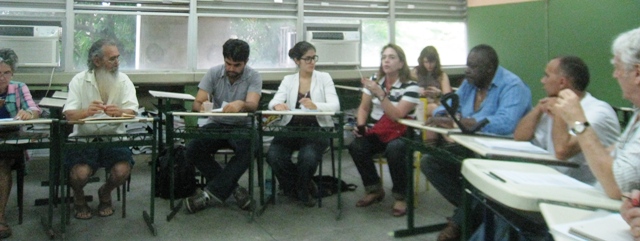– Rocinha –
 On Saturday November 26th there was a conference hosted by the Community Board of Rocinha, São Conrado and Gávea. The event was held at the Ayrton Senna public school, located on the São Conrado side of the new pedestrian bridge at the foot of Rocinha. The Community Board (Câmara Comuitaria) of Rocinha, São Conrado and Gávea has been described in previous posting, but it is essentially a civil society group that meets on issues concerning these three neighborhoods. Members of the Community Board participate in one (or possible more than one) of the nine thematic groups. The conference on Saturday had a very specific goal — to agree upon three priorities from each of the nine thematic groups (henceforth GT, from the Portuguese Grupos Temáticos). The nine GTs are:
On Saturday November 26th there was a conference hosted by the Community Board of Rocinha, São Conrado and Gávea. The event was held at the Ayrton Senna public school, located on the São Conrado side of the new pedestrian bridge at the foot of Rocinha. The Community Board (Câmara Comuitaria) of Rocinha, São Conrado and Gávea has been described in previous posting, but it is essentially a civil society group that meets on issues concerning these three neighborhoods. Members of the Community Board participate in one (or possible more than one) of the nine thematic groups. The conference on Saturday had a very specific goal — to agree upon three priorities from each of the nine thematic groups (henceforth GT, from the Portuguese Grupos Temáticos). The nine GTs are:
- Urbanism & Environment
- Health and Education
- Sports and Leisure
- Work and Income
- Tourism
- Communication
- Culture
- Human Rights
- Youth.
On Saturday I participated in the Urbanism & Environment GT because I have been part of this group since it was established earlier in 2011. All the GTs are important, but for many of the issues Mundo Real engagement with the Urbanism & Environment GT is of particular significance because it addresses issues related to PAC 1 and PAC 2, Rocinha’s infrastructure, forced evictions, housing and other themes related to urban planning and development in Rocinha. Ruth Jurberg also participated in the Urbanism & Environment GT. Ruth is from the Canteiro Social do PAC which is basically the social services project of PAC. She has held this position, which is under the auspice of the state government’s Casa Civil since 2007. As head of PAC’s Canterio Social she is responsible for social projects in the communities of Rocinha, Complexo do Alemão and Manguinhos.
The increasing attention from outside Rocinha is becoming an issue that has some community residents and activists on guard…
There were about 140 people at the conference, of which approximately 30% were from Rocinha. The increasing attention from outside Rocinha is becoming an issue that has some community residents and activists on guard, because before the UPP process began the Community Board meetings were small and roughly 95% comprised of Rocinha’s residents. The newfound attention is in many ways positive for a community that has long been neglected. The totalitarian regime that existed here before November 13th made it very difficult (or impossible) for certain entities to operate in Rocinha. While some new faces are certainly welcomed the thing to be wary of is that with this new attention (and speculation) there are also many wolves in sheep’s clothing, hoping to profit off of the ‘new Rocinha.’
 There were 25 participants in the Urbanism & Environment GT. During the 1 hour and 20 minutes that we were split up into GTs several important issues were raised. As usual I mentioned the evictions in Laboriaux and was pleased that we discussed this theme for some time. In the end it was added to the list of priorities but did not make the top three. Regarding Laboriaux, Ruth advised residents to seek clarification from the City because according to her it is the municipal government of Rio de Janeiro that is responsible for Laboriaux’s fate, not the state government. While this is ‘technically true’ the issue is more complex and the state does have the power to intervene. Nonetheless, Seu Martins and I arranged a meeting with the UPP Social’s local administrator, Eduardo Alencar, after the meeting, to discuss the situation in Laboriaux. It is important to note that while the UPP Social originated as a state government program it was passed on to the City about 18 months ago. We have arranged a meeting with the UPP Social in Laboriaux for the week of December 5th.
There were 25 participants in the Urbanism & Environment GT. During the 1 hour and 20 minutes that we were split up into GTs several important issues were raised. As usual I mentioned the evictions in Laboriaux and was pleased that we discussed this theme for some time. In the end it was added to the list of priorities but did not make the top three. Regarding Laboriaux, Ruth advised residents to seek clarification from the City because according to her it is the municipal government of Rio de Janeiro that is responsible for Laboriaux’s fate, not the state government. While this is ‘technically true’ the issue is more complex and the state does have the power to intervene. Nonetheless, Seu Martins and I arranged a meeting with the UPP Social’s local administrator, Eduardo Alencar, after the meeting, to discuss the situation in Laboriaux. It is important to note that while the UPP Social originated as a state government program it was passed on to the City about 18 months ago. We have arranged a meeting with the UPP Social in Laboriaux for the week of December 5th.
The absolute rejection … of the plan to spend R$500 million ($300 million) to build a teleférico in Rocinha
Again, housing in Laboriaux is an issue I wanted to see make the top three priorities, but Rocinha is an enormous community with many complex issues that also need to be addressed. Also, other residents from Laboriaux who were present raised the issue in their respective GTs, and one of them, Ricardo, succeeded in getting us into the top three.
The top three priorities agreed upon in the Urbanism & Environment GT were:
- answers regarding when PAC 1 will be completed and when PAC 2 will begin,
- The absolute rejection, with the exception of Ruth Jurberg who was in favor, of the plan to spend R$500 million ($300 million) building a teleférico in Rocinha and
- clarification on the status of the Parque Ecológico da Rocinha (Rocinha’s Eco Park). Essentially, all of these issues were addressed to Ruth Jurberg.

In this sense we were lucky to have her in our group because she helped narrowing down doubts and priorities. Ruth, in theory, serves the deliberative function of delivering the boards suggestions to the appropriate state (and possibly municipal and federal) legislative representatives and assemblies. Ruth made it clear that PAC 2 can only begin after PAC 1 has been completely finished. This is frustrating because PAC 1 went almost 40% over budget and left about 35% of the proposed designs unfinished. The money ‘mysteriously’ disappeared and the work was left incomplete. Now the state government has asked for an additional R$50 million ($30 million) to finish PAC 1. One participant interjected, ‘I saw with my own eyes on countless occasions, trucks that were supposed to be delivering PAC 1 material being heading to areas of Rocinha and outside of Rocinha that they had no business being in.’ Ruth promised this issue would be investigated. Another point raised several times was that of the chic soccer pitch that was built with PAC 1 money. Everyone knows this concrete pitch and the related amenities around it were built for Rocinha’s drug traffickers to play soccer on and to party afterwards. Not only did they divert hundreds of thousands of dollars to build it they also deforested a federally protect area of Tijuca National Forest to do so. This is a prime example of how local level corruption interferes in ‘development’ programs in communities like Rocinha. Ruth claimed to not know about the expensive soccer pitch. Ruth added that PAC 2 had already begun in the Canto Galo community and estimated that it would be another year before it could begin in Rocinha.
After the GT meetings we return to the general assembly room and each GT presented their lists of priorities. Ruth did not stay for this part of the conference, to the dismay of many who did. Ricardo, a long time resident of Laboriaux, managed to get the critical issue of Public School Abelardo Chacrinha Barbosa (the elementary school in Laboriaux that served over 300 kids and which was closed for no valid reason in Abril of 2010) in the top three priorities of the Education and Health GT. We will make the list of top priorities available soon.
In short, the Community Board was born out of the PAC 1 Canteiro Social. It serves as an important space in which issues that are pertinent to Rocinha, São Conrado and Gávea are raised. It is by no means the only way to do so. The interesting thing, however, is that there has been a tremendous amount of interest in all things ‘Rocinha’ since the UPP process began on the 13thof November. The Community Board meetings were small and almost solely Rocinha before. Now they are growing and attracting plenty of outside attention. While this may be good on the one hand, on the other it appears that hordes of people, businesses, NGOs and other entities that have long wanted a slice of the Rocinha pie are trying to get their grab at it now that the UPP process is offering them a chance. Rocinha has become like some kind of favela gold rush, where everyone is trying to make a name or get rich quick. Before the plunder went almost exclusively to the drug traffickers, corrupt politicians and businessmen and a few other underworld groups — now apparently any one can make it big in the slum.


You must be logged in to post a comment.